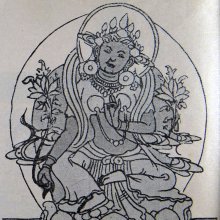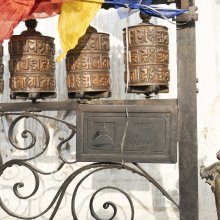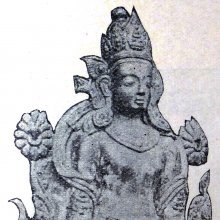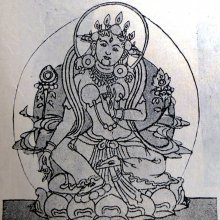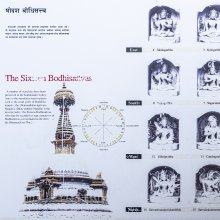Pandara, Pāṇḍara, Paṇḍara, Pāṇḍarā, Pamdara: 24 definitions
Introduction:
Pandara means something in Buddhism, Pali, Hinduism, Sanskrit, the history of ancient India, Jainism, Prakrit. If you want to know the exact meaning, history, etymology or English translation of this term then check out the descriptions on this page. Add your comment or reference to a book if you want to contribute to this summary article.
Images (photo gallery)
In Hinduism
Purana and Itihasa (epic history)
Source: archive.org: Puranic EncyclopediaPāṇḍara (पाण्डर).—A serpent born of the race of Airāvata. This serpent was burnt to death at the sarpasatra of Janamejaya. (Śloka 11, Chapter 57, Ādi Parva).
Source: Cologne Digital Sanskrit Dictionaries: The Purana IndexPāṇḍara (पाण्डर).—A hill west of the Śitoda.*
- * Vāyu-purāṇa 36. 28; 38. 49.
Pāṇḍara (पाण्डर) is a name mentioned in the Mahābhārata (cf. I.52.10, I.57) and represents one of the many proper names used for people and places. Note: The Mahābhārata (mentioning Pāṇḍara) is a Sanskrit epic poem consisting of 100,000 ślokas (metrical verses) and is over 2000 years old.

The Purana (पुराण, purāṇas) refers to Sanskrit literature preserving ancient India’s vast cultural history, including historical legends, religious ceremonies, various arts and sciences. The eighteen mahapuranas total over 400,000 shlokas (metrical couplets) and date to at least several centuries BCE.
Shaivism (Shaiva philosophy)
Source: Brill: Śaivism and the Tantric TraditionsPāṇḍara (पाण्डर) refers to “pale (ash)”, according to the 9th-century Sarvajñānottaratantra chapter 18.—Accordingly, “Next, I shall teach the best observance among observances, which is known as the Śiva-vrata and which is revered by Asuras and Gods alike. Pure pale (pāṇḍara) ash [should be used, and] white dress and unguents; he should wear a white sacred thread and be adorned by a chignon of matted locks. He should be equipped with all [suitable] ornaments, [and] adorned with white garlands; he should consume [only the pure ritual gruel-offering known as] caru; he should observe the chaste conduct of a student; he should venerate Śiva, the fire and his Guru. [...]”.

Shaiva (शैव, śaiva) or Shaivism (śaivism) represents a tradition of Hinduism worshiping Shiva as the supreme being. Closely related to Shaktism, Shaiva literature includes a range of scriptures, including Tantras, while the root of this tradition may be traced back to the ancient Vedas.
In Buddhism
Theravada (major branch of Buddhism)
Source: Pali Kanon: Pali Proper Names1. Pandara, Pandaraka
A Naga king. See Pandara Jataka.
2. PandaraThe name of the horse ridden by Mangala Buddha when he left household life. BuA.116.
3. PandaraA clan of elephants, each having the strength of one thousand men. UdA.403; VibhA.397; AA.ii.822.
4. PandaraThe name of a gotta. An ascetic of this clan, hearing Phussa Thera preach, asked him a question which led to a long explanation by Phussa (Thag.vs.949; ThagA.ii.82ff). It is said that the gotta had, as ancestor, a sage named Pandara. v.1. Pandarasa.
Theravāda is a major branch of Buddhism having the the Pali canon (tipitaka) as their canonical literature, which includes the vinaya-pitaka (monastic rules), the sutta-pitaka (Buddhist sermons) and the abhidhamma-pitaka (philosophy and psychology).
Tibetan Buddhism (Vajrayana or tantric Buddhism)
Source: archive.org: The Indian Buddhist IconographyPāṇḍarā (पाण्डरा) or Pāṇḍaravāsinī is the Śakti, or female counterpart (spiritual consort) of Amitābha: one of the Dhyāni-Buddhas, according to Vajrayāna or Tantric Buddhism.—Her colour is red; and her symbol is a lotus.—Pāṇḍarā is also called Pāṇḍaravāsinī. According to a Dhyāna in the Advayavajrasaṃgraha she belongs to the Lotus family which is also the family of the Dhyāni Buddha Amitābha. Pāṇḍarā thus is the spiritual consort of Amitābha.
Pāṇḍarā’s form and nature are described as under:—“In the Vāyu corner on the orb of the moon there is Pāṇḍaravāsinī originating from the (red) germ syllable Pāṃ. She is redin colour and has the Padma (lotus) as her recognition symbol. She is the embodiment of the element of Fire. She belongs tothe Lotus family and is full of attachment”.
Source: Wisdomlib Libary: VajrayoginiPāṇḍarā (पाण्डरा) is an alternative name of Ākarṣaṇī: a deity to be contemplated upon by a practicioner purifying his correspondences (viśuddhi), according to the 12th-century Abhisamayamañjarī. Ākarṣaṇī is alternatively known by the name Pāṇḍarā, one of the traditional consorts of the Buddha and a mother of the yogatantra system. The contemplation is prescribed as a preliminary ritual for a yogin wishing to establish, or reestablish the union with a deity.
Pāṇḍarā is associated with the element fire and the color red. She is to be visualised as assuming a kāpālika form, naked with loose hair and holding tantric attributes in their four arms.
Source: academia.edu: The Structure and Meanings of the Heruka MaṇḍalaPāṇḍarā (पाण्डरा) or Pāṇḍarī is the name of a Ḍākinī who, together with the Vīra (hero) named Pāṇḍara forms one of the 36 pairs situated in the Hṛdayacakra, according to the 10th century Ḍākārṇava chapter 15. Accordingly, the hṛdayacakra refers to one of the four divisions of the sahaja-puṭa (‘innate layer’), situated within the padma (lotus) in the middle of the Herukamaṇḍala. The 36 pairs of Ḍākinīs [viz., Pāṇḍarā] and Vīras are reddish yellow in color; they each have one face and four arms; they hold a skull bowl, a skull staff, a small drum, and a knife.
Note: Pāṇḍarā or Pāṇḍarī is also known as Pāṇḍaravāsinī while Pāṇdara is known as Pāṇḍaravāsa.
Source: OSU Press: Cakrasamvara SamadhiPāṇḍarā (पाण्डरा) is the name of a deity [i.e., oṃ pāṇḍarāyai svāhā], according to the Guru Mandala Worship (maṇḍalārcana) ritual often performed in combination with the Cakrasaṃvara Samādhi, which refers to the primary pūjā and sādhanā practice of Newah Mahāyāna-Vajrayāna Buddhists in Nepal.—Accordingly, “Locanī, having a golden color, arrow and shining appearance, Māmakī, having a dark-blue color, water, grain and a bouquet, Pāṇḍarā, having a red color, and drawing a bow and arrow, Holy goddess Ārya Tārā, having a green color and blue lotus”.

Tibetan Buddhism includes schools such as Nyingma, Kadampa, Kagyu and Gelug. Their primary canon of literature is divided in two broad categories: The Kangyur, which consists of Buddha’s words, and the Tengyur, which includes commentaries from various sources. Esotericism and tantra techniques (vajrayāna) are collected indepently.
India history and geography
Source: Singhi Jain Series: Ratnaprabha-suri’s Kuvalayamala-katha (history)Paṇḍara (पण्डर) refers to one of the sixty doctrines of different religious sects that existed in ancient India, as mentioned by Uddyotanasūri in his 8th-century Kuvalayamālā (a Prakrit Campū, similar to Kāvya poetry).—Page 203.20 f.: There is a detailed description of about 60 doctrines of different religious sects and schools of philosophy that had developed before the time of Uddyotanasūri, for example, [Paṇḍara] [...]. This list of different sects of Uddyotanasūri’s may be compared with the lists given by Bāṇa in the Harṣacarita (Books 5, 8).

The history of India traces the identification of countries, villages, towns and other regions of India, as well as mythology, zoology, royal dynasties, rulers, tribes, local festivities and traditions and regional languages. Ancient India enjoyed religious freedom and encourages the path of Dharma, a concept common to Buddhism, Hinduism, and Jainism.
Languages of India and abroad
Pali-English dictionary
Source: BuddhaSasana: Concise Pali-English Dictionarypaṇḍara : (adj.) white.
Source: Sutta: The Pali Text Society's Pali-English DictionaryPaṇḍara, (adj) (Ved. pāṇḍara; cp. paṇḍu, q. v. for etym. ) white, pale, yellowish J. II, 365; V, 340; Nd1 3; Dhs. 6= Vbh. 88 (Dhs. trsl. “that which is clear”? in def. of citta & mano) Dhs. 17, 293, 597; Miln. 226; DhA. IV, 8; VvA. 40; PvA. 56 (=seta); Sdhp. 430. (Page 404)

Pali is the language of the Tipiṭaka, which is the sacred canon of Theravāda Buddhism and contains much of the Buddha’s speech. Closeley related to Sanskrit, both languages are used interchangeably between religions.
Sanskrit dictionary
Source: DDSA: The practical Sanskrit-English dictionaryPāṇḍara (पाण्डर).—a. Whitish, pale-white; यत् कङ्कालमकालपाण्डुरघनप्रस्पर्धि रुन्धन्नभः (yat kaṅkālamakālapāṇḍuraghanapraspardhi rundhannabhaḥ) Mv.5.39.
-ram 1 Red-chalk.
2) The blossom of the jasmine.
3) Semen virile; पाण्डरं शुक्र- मित्याहुः (pāṇḍaraṃ śukra- mityāhuḥ) Dhyāna. Up.87.
Source: Cologne Digital Sanskrit Dictionaries: Edgerton Buddhist Hybrid Sanskrit DictionaryPaṇḍara (पण्डर).—(= Pali id.), name of a nāga king: Mahāvyutpatti 3281.
--- OR ---
Pāṇḍara (पाण्डर).—see next, and s.v. Pāṇḍava.
--- OR ---
Pāṇḍarā (पाण्डरा).—(in Dharmasaṃgraha 4 text Pāṇḍurā, v.l. °arā which probably read), name of a Buddhist goddess, associated with Tārā, and probably identical with prec.: Sādhanamālā 18.15 etc.; Dharmasaṃgraha 4.
Source: Cologne Digital Sanskrit Dictionaries: Shabda-Sagara Sanskrit-English DictionaryPāṇḍara (पाण्डर).—mfn.
(-raḥ-rā-raṃ) Pale or yellowish white. m.
(-raḥ) 1. Pale or yellowish white, (the colour.) 2. A plant, commonly Marua or Maruvaka. n.
(-raṃ) 1. Many-flowered jasmine. 2. Red chalk. E. paḍi to go, ar Unadi aff., and the radical vowel made long; also pāṇḍura.
Source: Cologne Digital Sanskrit Dictionaries: Benfey Sanskrit-English DictionaryPāṇḍara (पाण्डर).—akin to pāṇḍu, I. adj., f. rā, Pale, yellowish, white, [Rāmāyaṇa] 3, 2. 17 Gorr. Ii. m. 1. The name of a mountain. 2. The name of a Nāga or serpent.
Source: Cologne Digital Sanskrit Dictionaries: Cappeller Sanskrit-English DictionaryPāṇḍara (पाण्डर).—[adjective] whitish yellow.
Source: Cologne Digital Sanskrit Dictionaries: Monier-Williams Sanskrit-English Dictionary1) Pandara (पन्दर):—m. Name of a mountain, [Viṣṇu-purāṇa]
2) Pāṇḍara (पाण्डर):—a pāṇḍava See under pāṇḍu.
3) [from pāṇḍu] b mf(ā)n. whitish-yellow, pale, white, [Śatapatha-brāhmaṇa] (cf. -vāsas) etc. etc.
4) [v.s. ...] m. a species of plant, [cf. Lexicographers, esp. such as amarasiṃha, halāyudha, hemacandra, etc.]
5) [v.s. ...] Name of a mountain, [Mārkaṇḍeya-purāṇa]
6) [v.s. ...] of a Naga (also raka), [Mahābhārata]
7) [v.s. ...] of a sect (also raka), [cf. Lexicographers, esp. such as amarasiṃha, halāyudha, hemacandra, etc.]
8) Pāṇḍarā (पाण्डरा):—[from pāṇḍara > pāṇḍu] f. Name of a Buddhist Śakti or female energy, [Monier-Williams’ Buddhism 216] (cf. pāṇḍurā)
9) Pāṇḍara (पाण्डर):—[from pāṇḍu] n. a jasmine blossom, [cf. Lexicographers, esp. such as amarasiṃha, halāyudha, hemacandra, etc.]
10) [v.s. ...] red chalk, [cf. Lexicographers, esp. such as amarasiṃha, halāyudha, hemacandra, etc.]
Source: Cologne Digital Sanskrit Dictionaries: Yates Sanskrit-English DictionaryPāṇḍara (पाण्डर):—[(raḥ-rā-raṃ) a.] Pale yellowish white. m. Pale colour. n. Many flowered jasmine; red chalk.
Source: DDSA: Paia-sadda-mahannavo; a comprehensive Prakrit Hindi dictionary (S)Pāṇḍara (पाण्डर) in the Sanskrit language is related to the Prakrit word: Paṃḍara.
[Sanskrit to German]
Sanskrit, also spelled संस्कृतम् (saṃskṛtam), is an ancient language of India commonly seen as the grandmother of the Indo-European language family (even English!). Closely allied with Prakrit and Pali, Sanskrit is more exhaustive in both grammar and terms and has the most extensive collection of literature in the world, greatly surpassing its sister-languages Greek and Latin.
Prakrit-English dictionary
Source: DDSA: Paia-sadda-mahannavo; a comprehensive Prakrit Hindi dictionaryPaṃḍara (पंडर) in the Prakrit language is related to the Sanskrit word: Pāṇḍara.
Prakrit is an ancient language closely associated with both Pali and Sanskrit. Jain literature is often composed in this language or sub-dialects, such as the Agamas and their commentaries which are written in Ardhamagadhi and Maharashtri Prakrit. The earliest extant texts can be dated to as early as the 4th century BCE although core portions might be older.
Kannada-English dictionary
Source: Alar: Kannada-English corpusPaṃdara (ಪಂದರ):—[noun] a temporary shed, usu. a roof raised on poles, for providing shelter for larger number of people or for religious purposes; a pandal.
--- OR ---
Pāṃḍara (ಪಾಂಡರ):—
1) [adjective] of the colour of pure snow milk; white or somewhat white; white; whitish.
2) [adjective] lacking colour; colourless; faded.
--- OR ---
Pāṃḍara (ಪಾಂಡರ):—
1) [noun] the white colour.
2) [noun] a mendicant wearing white cloth.
3) [noun] an earthy clay coloured by iron oxide, usu. yellow or reddish brown (used as a pigment in paints); ochre.
Kannada is a Dravidian language (as opposed to the Indo-European language family) mainly spoken in the southwestern region of India.
See also (Relevant definitions)
Starts with (+14): Pamdaraga, Pandarabhasma, Pandarabhikshu, Pandaradanta, Pandaradvaragopura, Pandarajayashobhushana, Pandaraka, Pandarakavana, Pandarana, Pandaranga, Pandarapushpika, Pandarasa, Pandaravadai, Pandaravasa, Pandaravasas, Pandaravasin, Pandaravasini, Pandaravayasa, Pantara-kankani, Pantara-ulliruppu.
Ends with: Bilvapandara, Prapandara, Supandara.
Full-text (+50): Pandaravasini, Pandarapushpika, Pandarabhikshu, Pandura, Pandaravasa, Pandal, Pandarasa, Pandala, Pandalu, Pamdar, Pamdaru, Pandaradanta, Pandaravasin, Pandaravasas, Pandaradvaragopura, Vellai-cilaipantaram, Pantarakkariyam, Pandaraka, Pandari, Supandara.
Relevant text
Search found 29 books and stories containing Pandara, Pāṇḍara, Paṇḍara, Pāṇḍarā, Pāṇḍāra, Pamdara, Paṃḍara, Paṃdara, Pāṃḍara; (plurals include: Pandaras, Pāṇḍaras, Paṇḍaras, Pāṇḍarās, Pāṇḍāras, Pamdaras, Paṃḍaras, Paṃdaras, Pāṃḍaras). You can also click to the full overview containing English textual excerpts. Below are direct links for the most relevant articles:
The Indian Buddhist Iconography (by Benoytosh Bhattachacharyya)
Temples in and around Madurantakam (by B. Mekala)
Sri Ellaiamman Temple < [Chapter 3 - Temples of Madurantakam Taluk]
List of Mahabharata people and places (by Laxman Burdak)
Vietnamese Buddhist Art (by Nguyen Ngoc Vinh)
1. Physical appearance of Avalokitesvara < [Chapter 3 - Unifying factors of the Avalokitesvara Images in South Vietnam and South East Asia]
Mahabharata (English) (by Kisari Mohan Ganguli)
Section LVII < [Astika Parva]
Sripura (Archaeological Survey) (by Bikash Chandra Pradhan)
Scultures of Avalokitesvara < [Chapter 3 - Sculptural Programme]
